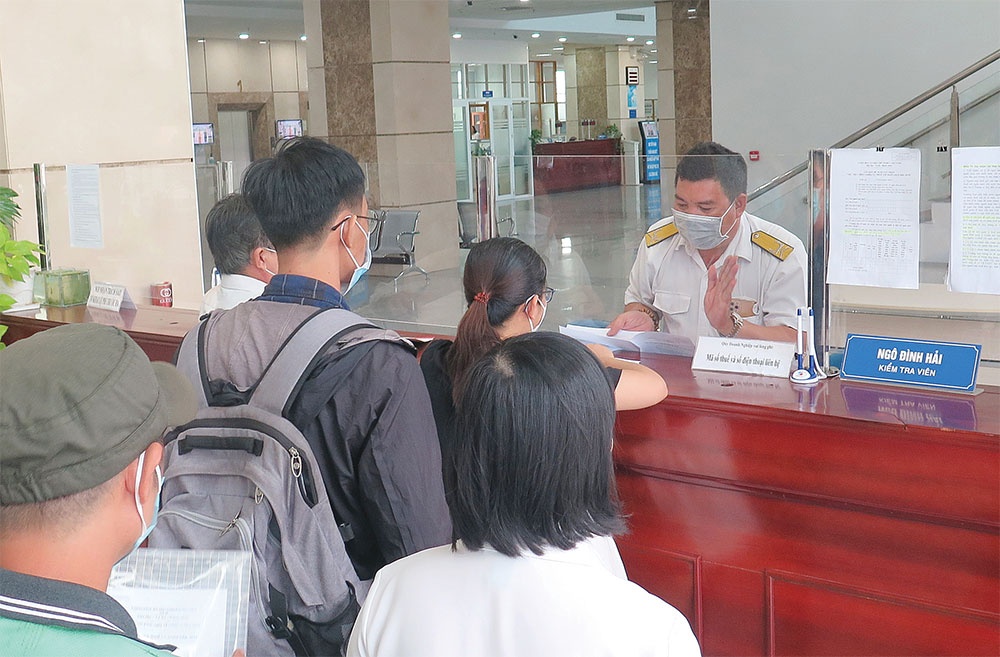Red tape reform offers up hope for smoother business
 |
| Thousands of regulations are being done away with or simplified in order to help individuals and enterprises push ahead in 2024, Photo: Le Toan |
Prime Minister Pham Minh Chinh two weeks ago issued a document to authorities at all levels nationwide, requiring them to urgently deploy further administrative reform in service of the public and businesses.
“Efforts are to be made to continue removing difficulties for production and business activities, and to boost, unleash, mobilise, and utilise all possible resources,” the document stated.
“All already-enacted policies and solutions in tax, fee, monetary, trade, and investment must be strictly put into practice. A decree on 2 per cent VAT reduction must be enacted soon under the National Assembly resolution,” it continued.
The Ministry of Finance (MoF) is now seeking comment from the public and enterprises for the draft decree, which will take effect between January and July next year.
The NA on November 29 adopted a resolution which covers a 2 per cent VAT decrease until late June 2024 for goods and services subject to a 10 per cent rate, with a view to “contributing to reducing prices of goods and services to promote production and business, generating more employment for labourers.”
The VAT scheme will not apply to the following goods and services: telecommunications, IT, financial activities, banking activities, securities, insurance, trading of real estate, metals, precast metal products, mining products (excluding coal mining), coke mining, refined oil, chemical products, and goods and services subject to excise taxes.
The government reported that the VAT reduction from July to October has helped provide a financial support worth $658.2 million for enterprises and individuals, contributing to decreasing prices of services and goods, therefrom helping to boost production and business activities and generate employment.
It is estimated that the decline in the state budget revenue will be about $176.1 million a month, meaning around $1.05 billion in the first six months of 2024.
According to the MoF, in 2023, a package of about $8.44 billion has been earmarked for supporting enterprises in the form of tax exemption and reduction. So far, $5.5 billion has been realised. In the coming time, another sum of $2.74 billion worth of budget revenue in 2022 will be added to the package.
Eradicating red tape
At a government cabinet meeting three weeks ago, PM Chinh ordered the continued review and improvement of the quality of legal regulations. Any improper regulations which are overlapped and cause difficulties to enterprises must be revised or removed in a manner of “creating the best for businesses.”
The government has also ordered the drastic continuation of administrative procedures and business conditions, and improvements in the quality of public services. Enterprises, especially smaller ones, must be further facilitated in access to preferential loans.
“It is a must to remove and decrease at least 10 per cent of compliance costs for administrative procedures and business regulations,” the government said in a report.
In 2024, the government “will complete all decentralising administrative procedures that are subject to the power of the government and prime minister, ensuring that at least 70 per cent of public services will be provided online and the rate of individuals performing such services will be at least 40 per cent.”
Since 2021, nearly 2,500 business regulations have been cut, reduced, and simplified. Since early this year, the government has cut, reduced, and simplified nearly 340 business regulations; simplified nearly 390 administrative procedures; and decentralised 156 administrative procedures.
The government’s strong move in quickening administrative reform and supporting businesses follows the fact that the economy is estimated to grow at a rate of over 5 per cent this year, far lower than the expected rates of 6-6.5 per cent, and the government is hoping the economy will grow 6-6.5 per cent next year.
“Meanwhile, some mechanisms, policies, and regulations are slowly being amended, while remaining contradictory, overlapping, and inconsistently applied. In many localities, reducing administrative procedures is slow and lacking in drastic measures,” said Minister of Planning and Investment Nguyen Chi Dung. “Rearranging and consolidating the state management apparatus and reducing intermediaries still have some shortcomings.”
Figures from the Ministry of Planning and Investment showed that in the first 11 months of this year, about 85,400 businesses halted operations – up 21.7 per cent as compared to the corresponding period last year; 57,200 enterprises stopped operations and waited for dissolution procedures – up 26.3 per cent; and nearly 16,200 enterprises completed such procedures, down 4 per cent. On average, about 14,400 businesses were kicked off from the market every month.
Continued vigilance
In the coming time, the government will continue improving the quality of reformation of the portfolio of conditional investment and business professions and business conditions. It will also review and revise conditional business professions and remove out of the portfolio the professions that can be applied to more effective management solutions.
“We will also revise and remove business conditions currently stipulated in specialised laws if such conditions are found illegal, unnecessary, infeasible, and unclear. In addition, the government will also review and revise all types of practising certificates in order to reduce their number and save costs for the society,” PM Chinh stated.
According to the World Bank, Vietnam’s economy may grow 4.7 per cent in 2023 due to weakening domestic and overseas demands, before gradually accelerating to 5.5 per cent in 2024 and 6 per cent in 2025.
“A proactive fiscal policy supporting short-term demand, removing barriers to the implementation of public investment, and addressing infrastructure constraints can help the economy achieve these targets and promote long-term growth,” the bank said.
It suggested last week that as the economy still faces headwinds, the authorities could consider extending the implementation of Programme on Socioeconomic Recovery and Development for 2022-2023 (PSRD) backed by a $15 billion monetary and fiscal package into next year to allow its planned investments to be fully implemented, supporting aggregate demand.
“Amid economic slowdown, financial sector vulnerabilities call for continued vigilance while efforts to restore confidence and promote a healthy development of the real estate markets will be key to supporting economic stability in the short term and economic growth in the long term,” the World Bank stated.
Cumulatively as of late September, total disbursement within the PSRD’s initiatives reached about VND96.4 trillion ($4.07 billion).
According to the National Assembly Economic Committee, over the past nearly two years, almost all support packages within the PSRD’s fiscal policy have seen slow-paced disbursement.
For example, the 2 per cent lending rate support package via the commercial bank system for enterprises, cooperatives, and household businesses has seen a very low disbursement rate – at only about VND781 billion ($32.95 million) or 1.95 per cent of the assigned total of VND40 trillion ($1.69 billion).
It is expected that by late 2023, total disbursement may reach about VND1.4 trillion ($59 million), tantamount to only 3.5 per cent of the total. In the sectors entitled to this financial support, only 13 per cent of customers have met loan conditions – of whom 67 per cent have no demand for such assistance.
| Revenue mobilisation efforts over the medium term are needed to reverse the trend of tax erosion and create space to bolster social spending and address infrastructure gaps. Tax revenues have been eroded since their peak in the late 2000s, in contrast to trends in regional peers (and despite Vietnam’s tax rates being close to peers’ average). Implementing the Tax System Reform Strategy 2021-2030 would help widen the tax base and enhance tax compliance. Reforms could include reducing exemptions and rationalising preferential regimes for foreign-invested enterprises, broadening the VAT base, and raising environmental tax and excise duties. The planned introduction of a unified property tax and a land registry would also be important. Strengthening the fiscal framework and budget processes would increase transparency and enhance the quality and effectiveness of fiscal policy. The budget process is weakened by overly conservative revenue projections in recent years. A budget based on realistic projections and assessment of risks would allow to better decide on the appropriate fiscal space and level of spending and debt, while increasing transparency. The scope and duration of permitted carryover spending could be more limited and ensure that all spending is integrated in the budget process. It would be important to accelerate efforts to strengthen macro-fiscal capacity (projections, risk assessment, impact of fiscal measures). Conducting expenditure reviews would help identify priorities and improve the quality of expenditures. Source: International Monetary Fund |
| Reform across the board for Quang Ninh State-owned group reform failing to meet expectations Slashing of red tape remains focal point for admin reform |
| Tran Quoc Phuong, deputy minister of Planning and Investment
The National Assembly has passed Resolution No.103/2023/QH15 on the socioeconomic development plan for 2024. The resolution states specific goals, tasks, and solutions for the year, such as economic growth of 6-6.5 per cent on the basis of specific analysis of the advantages and difficulties. To implement the set goals, Resolution 103 highlights 12 groups of comprehensive solutions in all sectors. In the past, we often set the goal and task of maintaining macroeconomic stability first, then other solutions. However, now the NA has decided to prioritise in 2024 a focus on promoting economic growth before stabilising the macroeconomy. This shows the strong determination of the entire political system to accelerate economic growth and recovery, and offset previous difficulties due to various impacts in the world economy in 2023. With such tasks, the Ministry of Planning and Investment (MPI) is responsible for presiding and coordinating with relevant ministries and sectors to develop Resolution No.01. It has submitted the first draft of Resolution 01 for government members to comment. After that, it will gather comments to complete this draft resolution for submission to a meeting between the government and localities in early January. This is a pivotal resolution and a backbone for the government’s economic monitoring for the whole of 2024. In this resolution, the MPI emphasised focused solutions for the priority goal of promoting economic growth in 2024 and striving to achieve the growth target of 6-6.5 per cent. A review of economic growth drivers shows that all aspects of investment, export, and consumption have good growth opportunities in 2024. Regarding exports, we are on a month-after-month recovery path, gradually regaining export growth momentum. As for consumption, currently the total retail sales of goods and consumer service revenue is over 9 per cent, which is also a strong momentum. And in investment, opportunities in state investment, foreign direct investment, and domestic private investment in 2024 are superb thanks to the results of economic diplomacy in 2023, especially in fields such as renewable energy, semiconductors, and other industries serving socioeconomic development. Jonathan Pincus, senior international economist United Nations Development Programme
The slowdown in domestic and foreign demand this year is an aftereffect of monetary policies pursued in recent years, made worse by the conflict in the Ukraine and US-China trade tensions. Central banks lowered interest rates and flooded markets with cash during the pandemic to prevent mass bankruptcies during lockdowns and social distancing. Businesses and households refinanced debt at lower rates and took out new loans to tide them over until earnings returned to normal. The policy worked, keeping many businesses afloat that would have otherwise been forced into liquidation. The negative effect of monetary easing was the creation of asset bubbles in the property and stock markets. The S&P 500 in the US more than doubled in value from the onset of the pandemic in March 2020 to its peak at the end of 2021. US house prices were up 42 per cent from December 2019 to June 2022 despite depressed household earnings. These asset bubbles could not be sustained in the face of rising interest rates and tighter liquidity. Companies that had borrowed too much money during the pandemic, and investors who made speculative bets on risky assets, experienced financial distress. Asset bubbles are a normal part of the business cycle. The problem for the macroeconomy is that falling asset prices have a negative effect on the balance sheets of financial institutions, prompting them to curtail lending to businesses and consumers. Central banks can ease the adjustment process by extending additional credit to banks and other financial institutions against good assets. However, this process will not work if it is difficult to price the banks’ assets because the financial accounts of big borrowers are inaccurate or impartial. The lack of corporate financial transparency is the main reason that secondary markets for bonds and loans have failed to take off here. It is difficult to assign prices to assets if investors are unsure about the viability of borrowers. |
What the stars mean:
★ Poor ★ ★ Promising ★★★ Good ★★★★ Very good ★★★★★ Exceptional
Related Contents
Latest News
More News
- Businesses ramp up production as year-end orders surge (December 30, 2025 | 10:05)
- Vietjet chairwoman awarded Labour Hero title (December 29, 2025 | 13:06)
- How to unlock ESG value through green innovation (December 29, 2025 | 10:03)
- AI reshapes media and advertising industry (December 29, 2025 | 08:33)
- FPT and GELEX sign deal to develop blockchain tech for global markets (December 29, 2025 | 08:29)
- Vietnam’s GDP forecast to grow by 9 per cent in 2026 (December 29, 2025 | 08:29)
- Women entrepreneurs are key to Vietnam’s economic growth (December 29, 2025 | 08:00)
- Vietnam's top 500 value-creating enterprises announced (December 27, 2025 | 08:00)
- The PAN Group shaping a better future with ESG strategy (December 26, 2025 | 09:00)
- Masan Consumer officially lists on HSX, marking the next phase of value creation (December 25, 2025 | 13:20)



 Tag:
Tag:





















 Mobile Version
Mobile Version